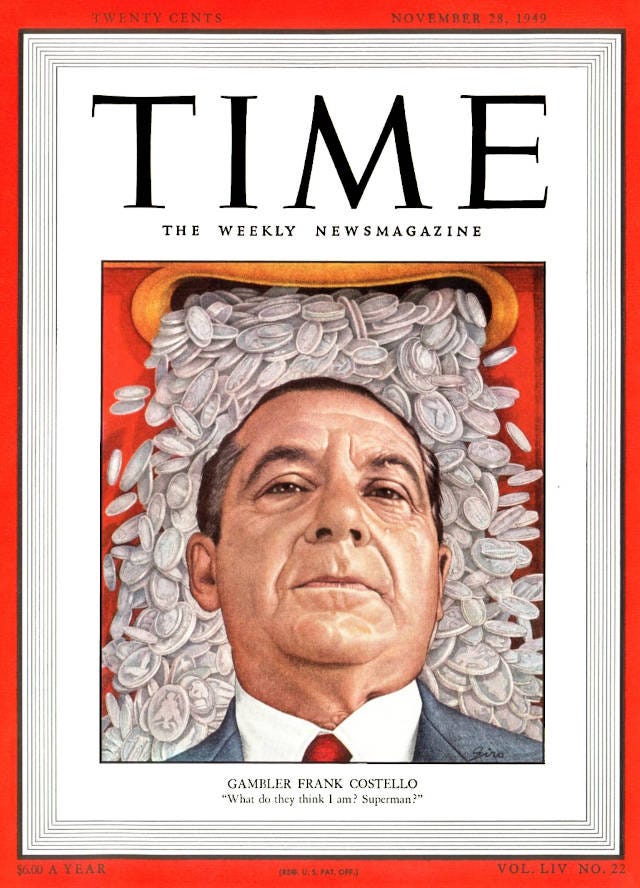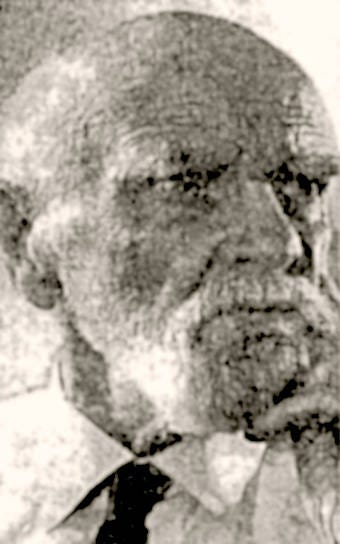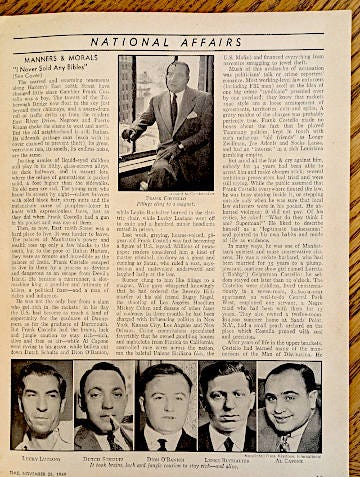Story of TIME's Costello cover
Response to reader question about the famous magazine portrait.
Michael, a longtime reader of Informer, wrote to me recently asking about the TIME magazine cover of November 28, 1949. That famous cover featured an illustration of New York Mafia boss Frank Costello in front of a flood of coins spilling from a slot machine's payout chute. Michael was interested in identifying the artist responsible for the illustration, now more than three-quarters of a century old.
He noted that the only suggestion of the artist's identity was the small signature in the lower right corner of the cover image. Somewhat difficult to spot, as it was presented in a dark color against the dark blue of Costello's suit jacket, the signature appeared to be the word “Giro,” written in script. Naturally assuming that was the artist's surname, Michael went in search of the artist's given name:
“...Wondering do you know the first name of the artist who painted the Costello TIME magazine cover... The name Giro was all I could find. No 1st name given...”
While “Giro” does have the sound of a surname, very much like “Giroux” or “Giraux” or “Gireoux,” it turned out not to be a surname at all. And, as tempting as it is to pronounce “Giro” with a soft “G” - something like “Jee-ro” - that wouldn't be correct either.
It turns out that the “Giro” in this case is intended to be pronounced with a hard “G” sound. The result is the phonetic equivalent of the artist's name: Guy Rowe.
Martin Guy Rowe
Born July 20, 1894, in Utah's Salt Lake County, Martin Guy Rowe (who later dropped the Martin portion of his name) had little in the way of formal education, leaving school around the fifth grade. In his youth he held a number of very different jobs, including tailor's assistant, railroad baggage handler and lumberjack. At one point, he was even employed as an acrobat on the vaudeville circuit.
He eventually found his way to art. That brought him back into a classroom. While supporting himself with a job at a car factory, he took instruction at the Detroit School of Fine Arts. He completed his studies in 1919 and married fellow artist Corinne Finsterwald in Detroit in that year.
By 1920, he launched his career as a commercial artist in New York City. His early jobs included fashion drawings, book jackets and some still-life paintings used by the National Biscuit Company in its advertisements.
(National Biscuit Company already had been using the abbreviated "Nabisco" name for a couple of decades, and that would later become the company's official name. Possibly, this helped inspire Guy Rowe's abbreviated art signature. But the fact that Rowe's father developed the Rowe Shorthand system may have played a significant part.)
The 1920 United States Census found him living with wife Corinne on Fort Washington Avenue in Manhattan's Washington Heights section. For the census, Rowe reported his occupation as “artist” for “Biscuit Co.”
Through his career, Rowe painted more than eighty portraits for the cover of TIME. And the Costello portrait is likely among his most memorable covers. Still, he became better known for a different project released in 1949. That was the Houston Harte-authored Oxford University Press book, In Our Image: Character Studies from the Old Testament. As illustrator, Rowe provided thirty-two realistic and emotional paintings of biblical characters for the book. The task reportedly took him three and a half years.
In addition, Rowe and his wife Corinne are generally credited with resurrecting an ancient painting technique, encaustic painting, which uses heated beeswax combined with pigment to produce works with great depth and translucence.
In his later years, Rowe lived at 4 Foley Place, Huntington Station, Suffolk County, New York. He passed away on August 25, 1969, at Huntington Hospital. He was seventy-five. He was survived by a son Charles, a sister Gertrude Welch of California, and four grandchildren.
TIME's Costello coverage
Veteran reporter James A. Bell, and other reporters across the country, worked for months on the Frank Costello article featured in the November 28, 1949, issue of TIME. In the course of his research, Bell bumped into Frank Costello at the New York office of a Costello attorney.
Costello reportedly was gracious toward the reporter and spoke with him for an hour and a half during that first meeting. The notorious crime figure met with Bell on two other occasions for lengthy interviews.
Bell compiled all of that information and everything else he had learned about Costello into a total of 181 typewritten pages of notes. Unfortunately, most of that information, including much of what Costello said in the interviews, did not make it into the finished TIME article.
National Affairs writer Paul O'Neil and the TIME editors produced a fairly lengthy article, running three and a half magazine pages (including ten photographs). But the comments from Costello's interview with Bell appear to have been condensed into about three paragraphs near the end of the article.
The included comments basically consisted of Costello denials of wrongdoing. The crime boss insisted that he was publicly blamed for many offenses simply because of great name recognition. He had become, in his own estimation, the “Coca-Cola” of organized crime.
The TIME story became something of a sensation, and it was reported in other media. Some newspapers, including the Tampa Tribune, republished the entire article in their pages.
Sources
Record of Births in Salt Lake City Utah, no. 2628, July 20, 1894, reported July 23, 1894.
Social Security Death Index, 079-28-4991, death August 1969, birth July 20, 1894.
United States Census of 1920, New York State, New York County, Assembly District 22, Enumeration District 1486.
“Facts about Guy Rowe,” askArt, askart.com.
“Guy Rowe, artist, dead at 75; paintings on 80 Time covers,” New York Times, Aug. 27, 1969, p. 40.
“National Affairs: Manners & Morals: ‘I never sold any bibles,’” TIME, Nov. 28, 1949, p. 15.
“Who was Guy Rowe?” Guy Rowe, American artist 1894-1968, guyrowe.com
Linen, James A., “A letter from the publisher,” TIME, Nov. 28, 1949, p. 9.













Thanks for writing this article it needed done for history's sake.